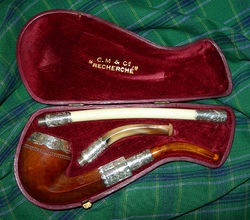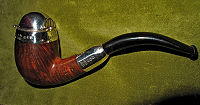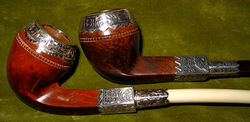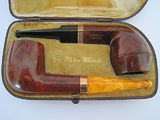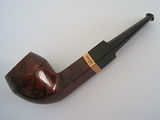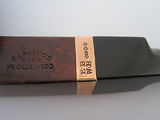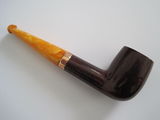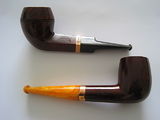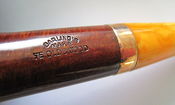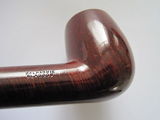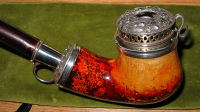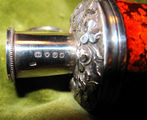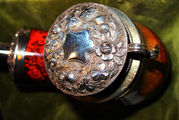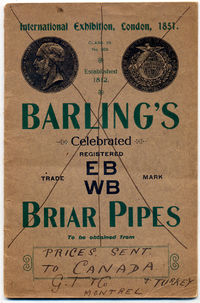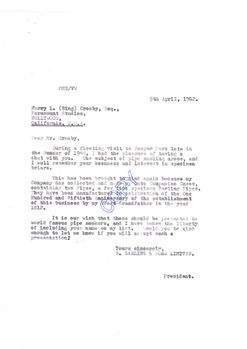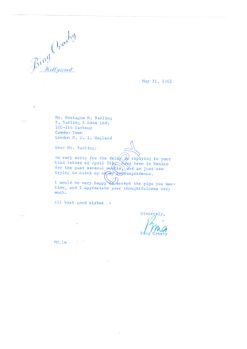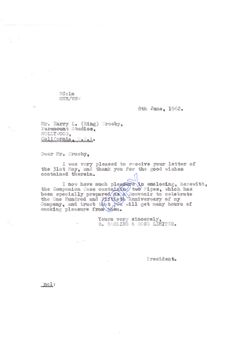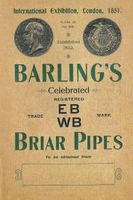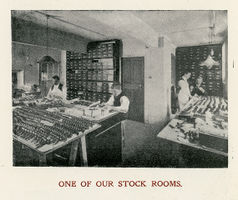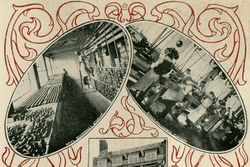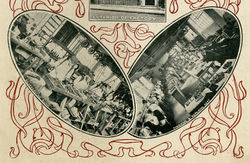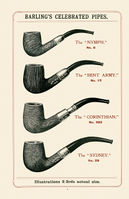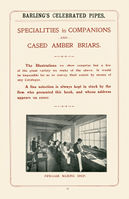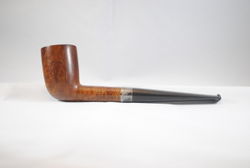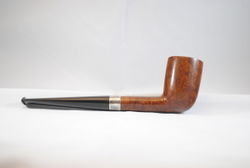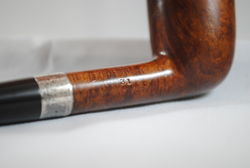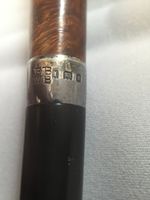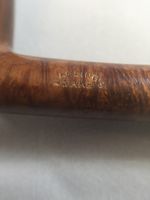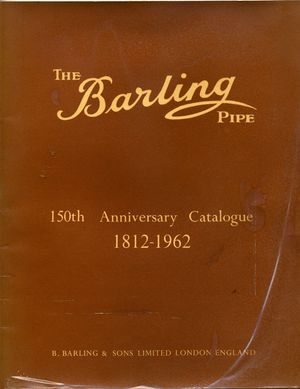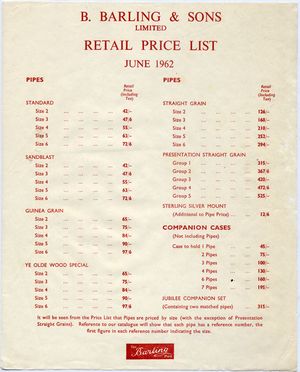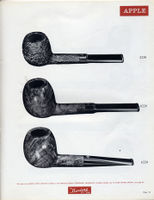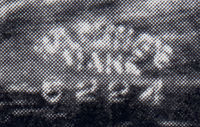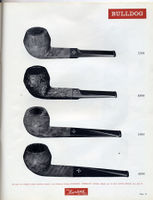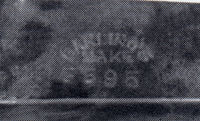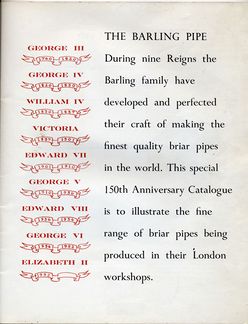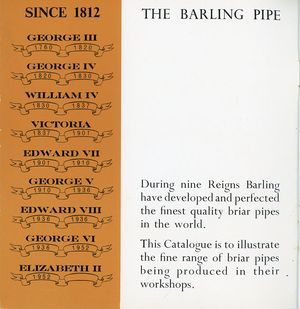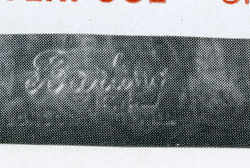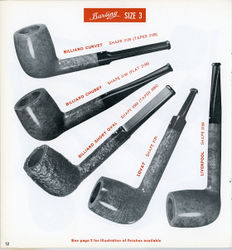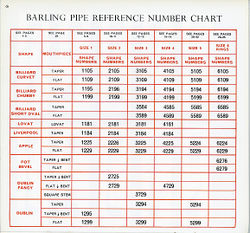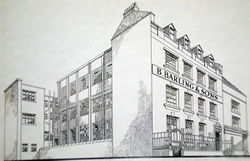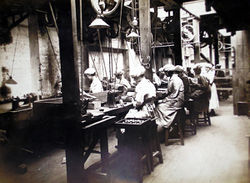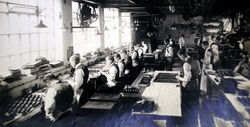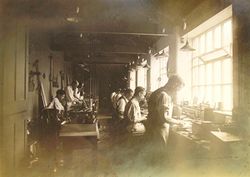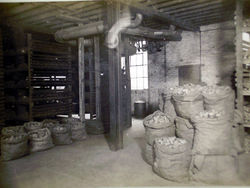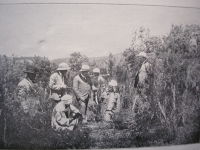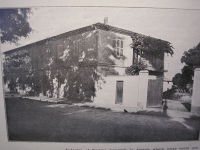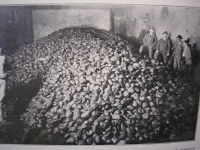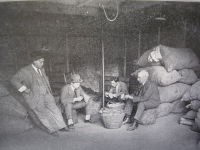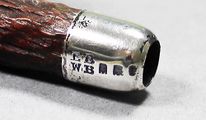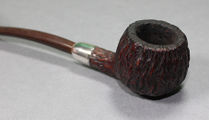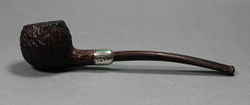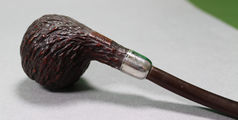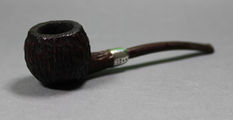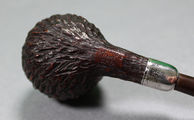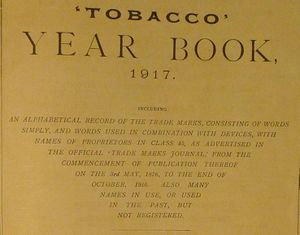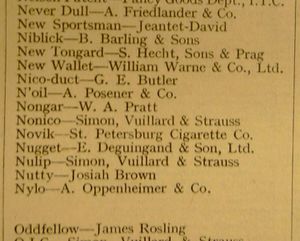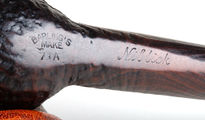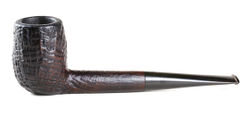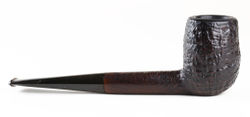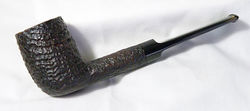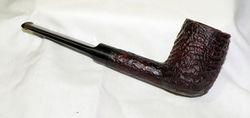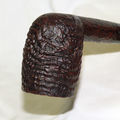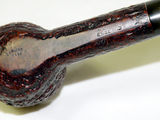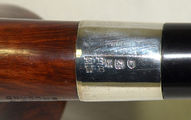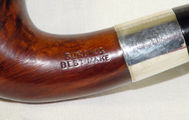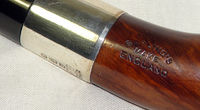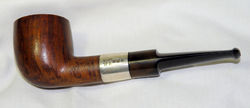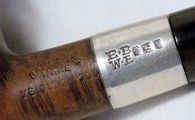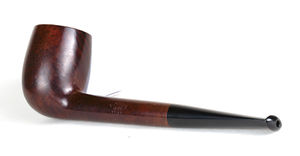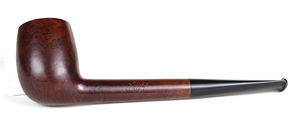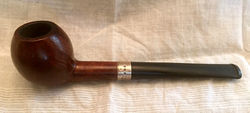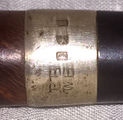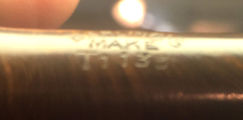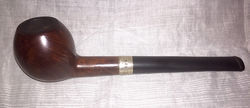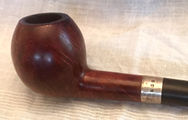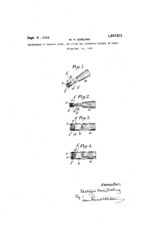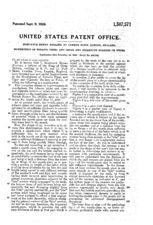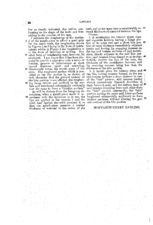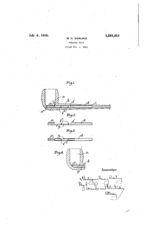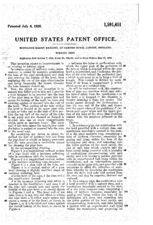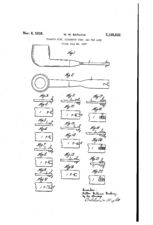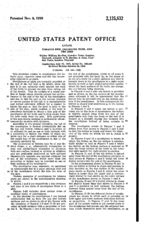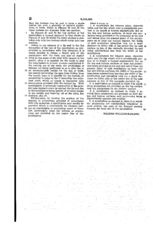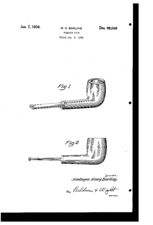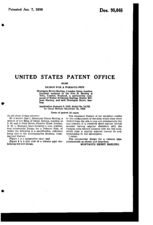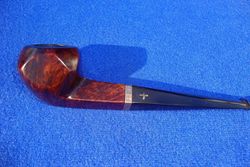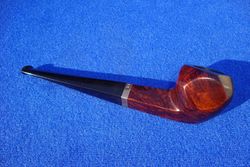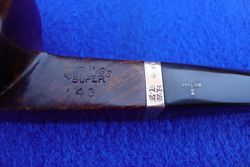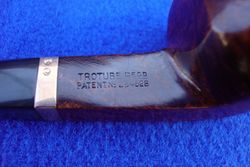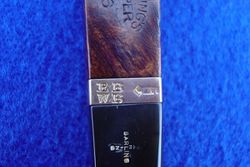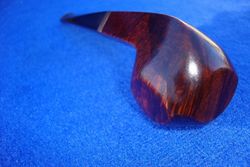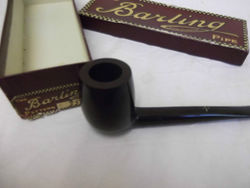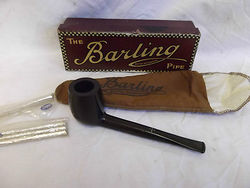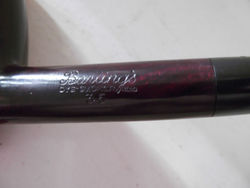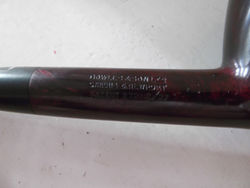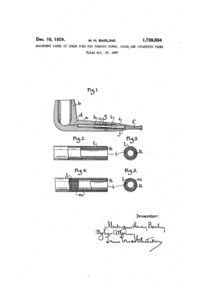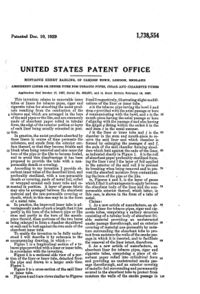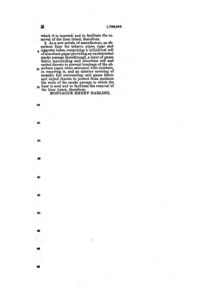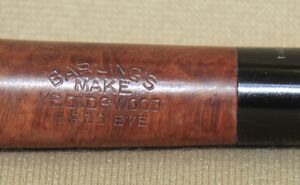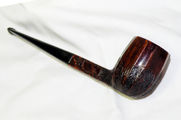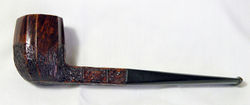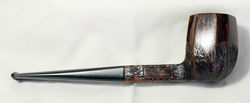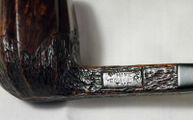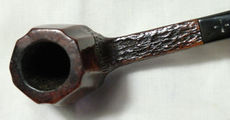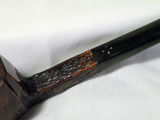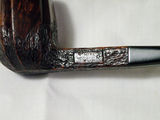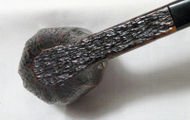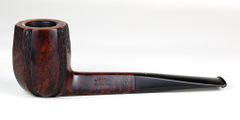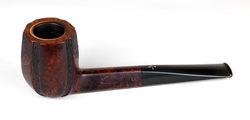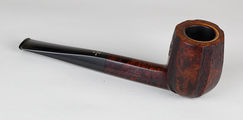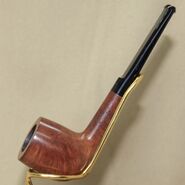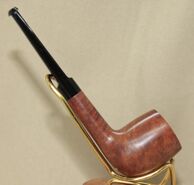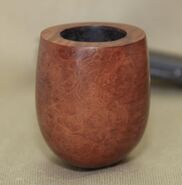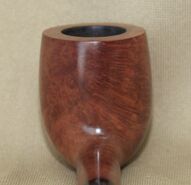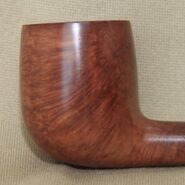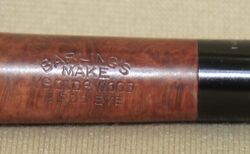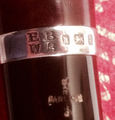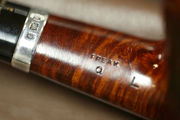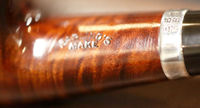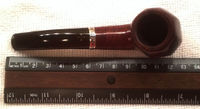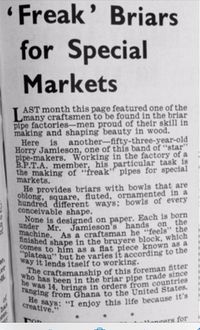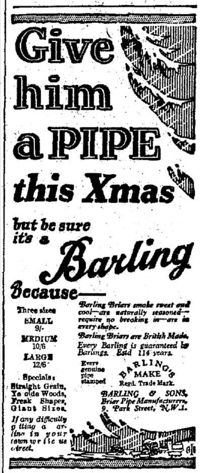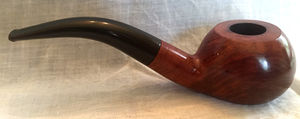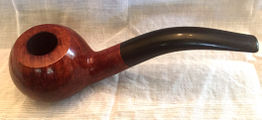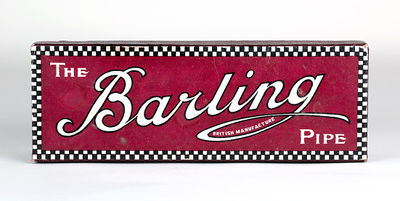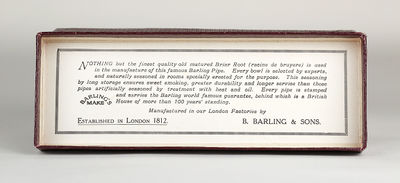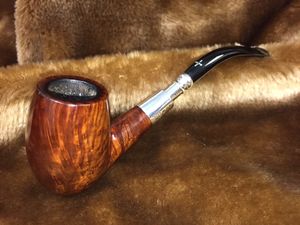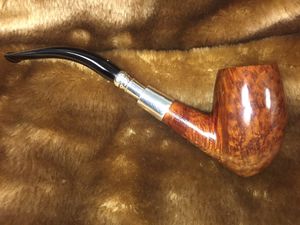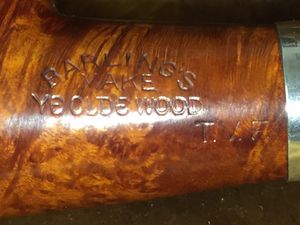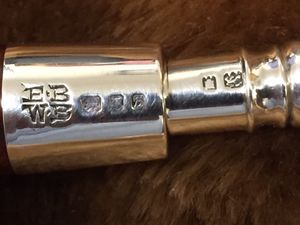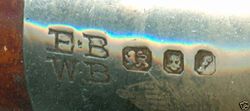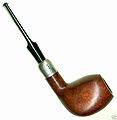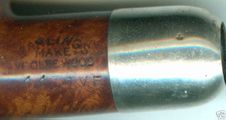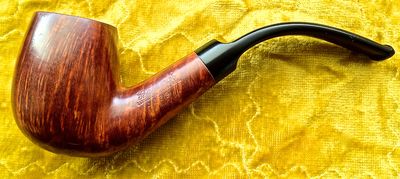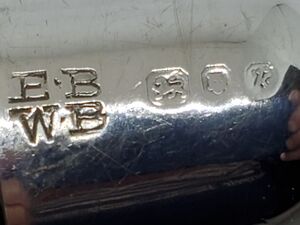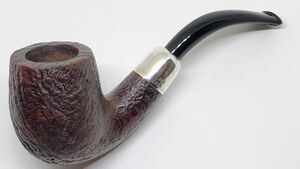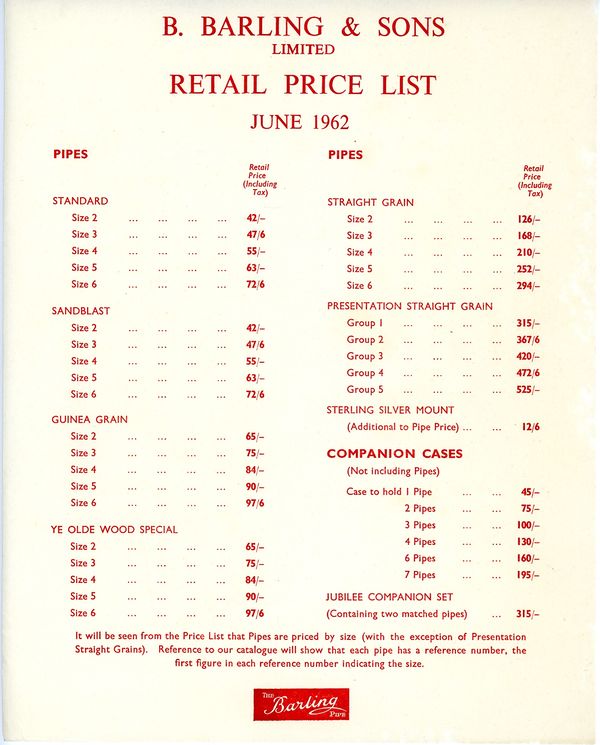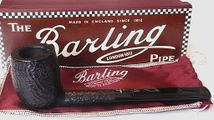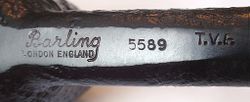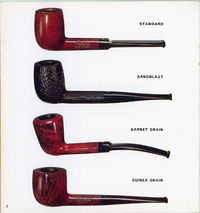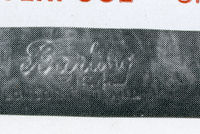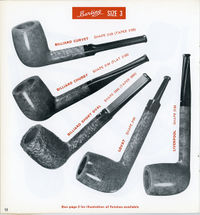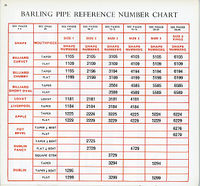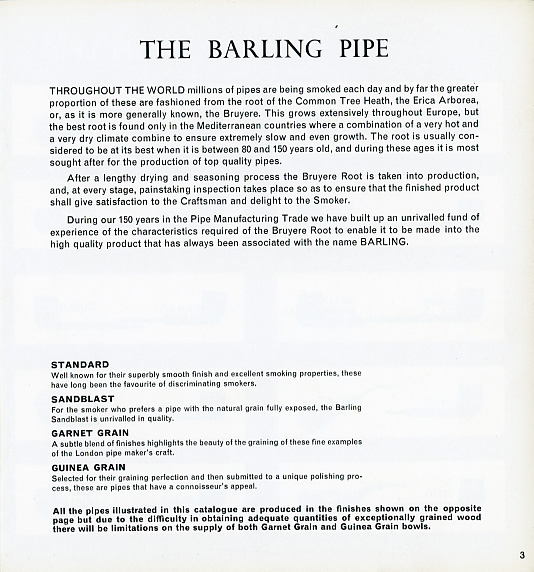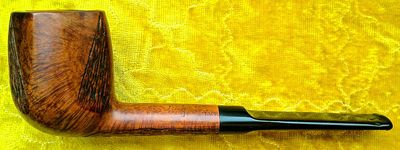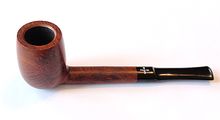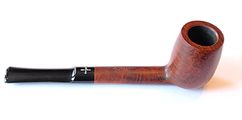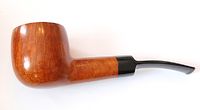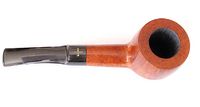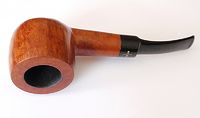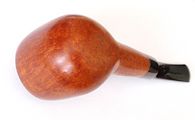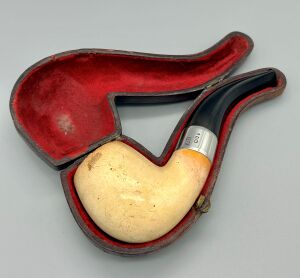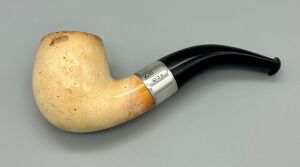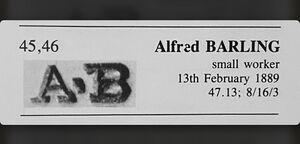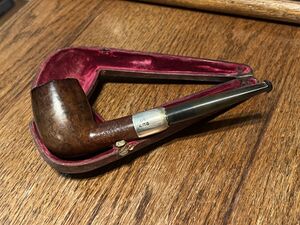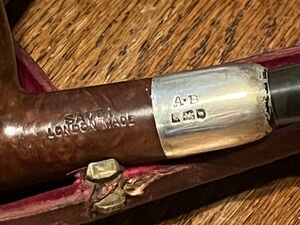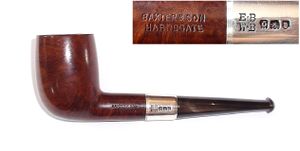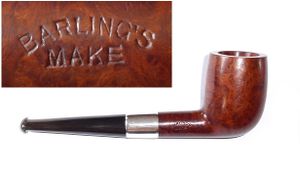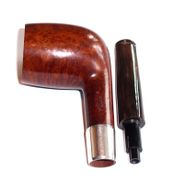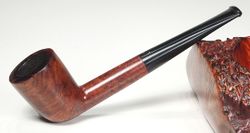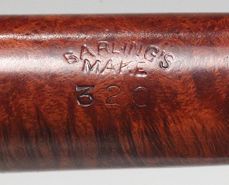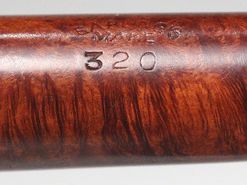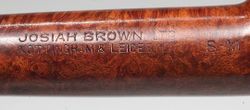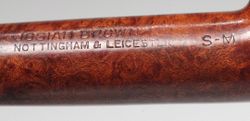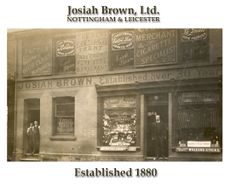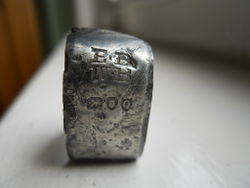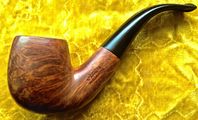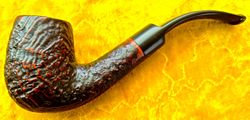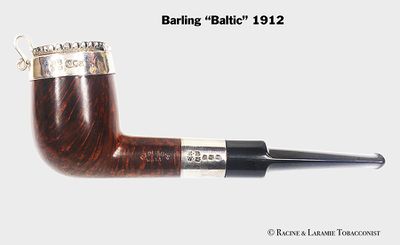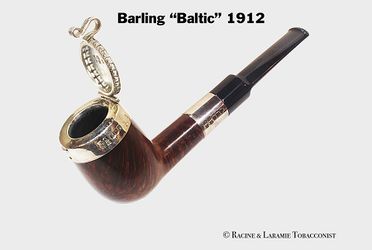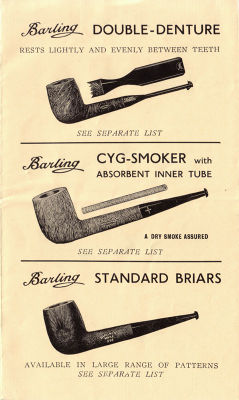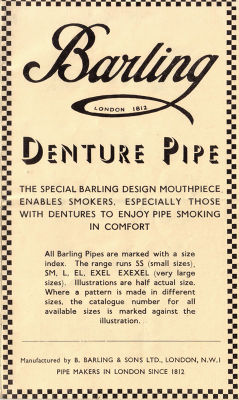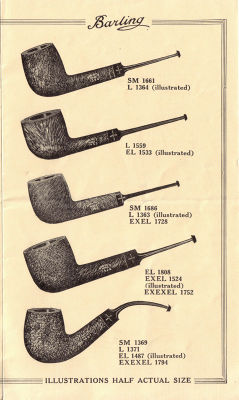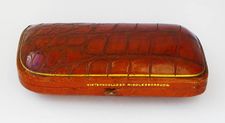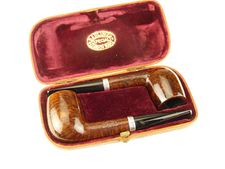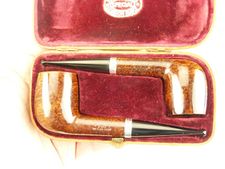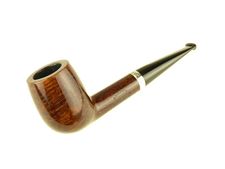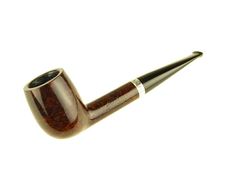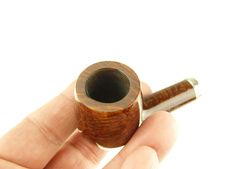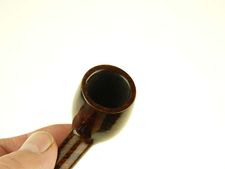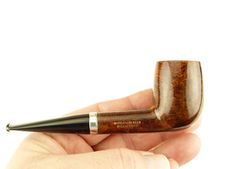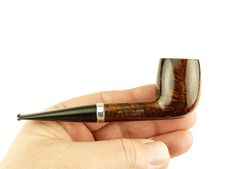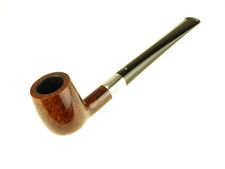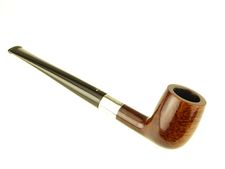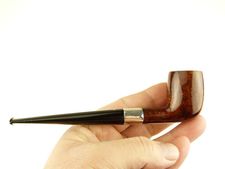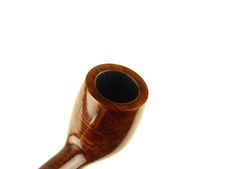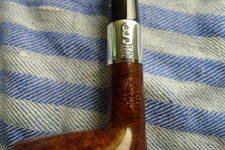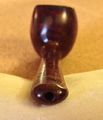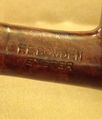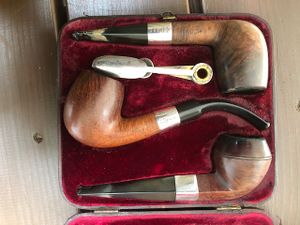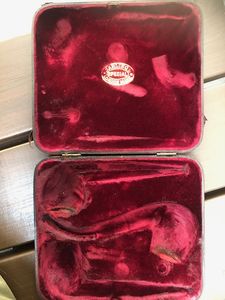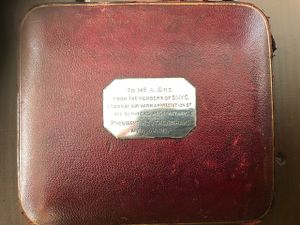Barling
New: This article is now available in Francais here: Barling.fr: Many thanks to Jean-Christophe Bienfait for his work on the translation.
Many thanks to Jesse Silver for extensive work editing and contributing to this article, as well as Tad Gage, Jon Guss, and Troy Lloyd for their input, expertise, and permission to use their research. Thanks to these dedicated pipemen we have made excellent progress on these last two revisions (July, 2013 and May, 2016). We are always looking for additional information and documentation on the fascinating history of Barling. sethile (talk) 17:27, 11 May 2016 (CDT)
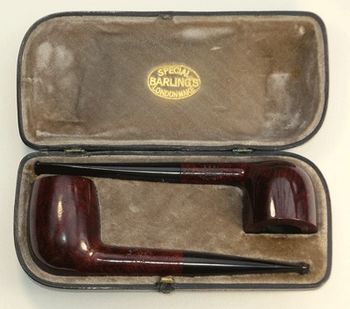
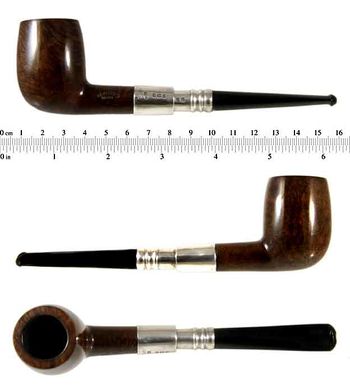
The Company
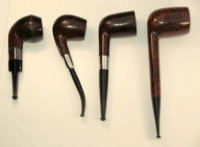
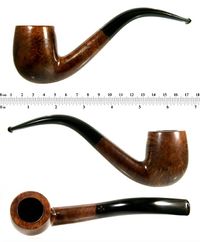
“We have much pleasure in presenting our New Catalogue illustrating some of the principal shapes and specialities in our celebrated EB WB Briar Pipes.
Our pipes being so well known and universally known (without the artificial aid of advertisements), we will not here dwell on their perfection, but would ask you to kindly peruse this book, which will no doubt introduce to you some new patterns.
If you are not already a smoker of our pipes, we hope that it will lead to your giving them a trial and thus testing their quality and workmanship, we ourselves being confident of your ultimate judgment and satisfaction. Every department of our factory being under our own practical and personal supervision, ensures every pipe turned out by us coming under our direct notice. This fact, coupled with the excellence of the materials used in their manufacture, has given our pipes a reputation second to none in the smoking world, a reputation we firmly intend to maintain and strengthen.
B. BARLING & SONS.
London”
Three years ago I wrote the following:
Every now and then there occurs an event of such gigantic impact that it literally changes the landscape. For the Dinosaurs it was the impact of an asteroid some 65 million years ago. For Barling scholars it is Jonathan Guss’ article, “How Many Angels? Another Look At The Barling Transition”, published on Neill Archer Roan’s superb site, A Passion For Pipes.
Where we poor mortals have written in generalities and offered educated guesses, Jon has provided detailed, exact, and thoroughly researched data that dispels many of the smoke clouds in which pipe history is enshrouded. Worse, Jon has presented this data in language so graceful and engaging that I’m left with the realization that at best, I write with both thumbs. Fortunately, Jon has graciously consented to allow me to incorporate some of his findings in this revision of the Barling page. For serious Barling enthusiasts Jon’s essay is a fundamental “must read”.”
Three years later, nothing in this statement has changed. Jon’s article is still the gold standard for research in this area. Unfortunately, as of this writing, Neill has closed his site. We can only hope that it will resurface at some future point, or that Jon will make his work available elsewhere.
I’m also indebted to Tad Gage, who has consented to share some very rare and important images and documents from his personal collection. In addition, Tad has added to, improved, and clarified points of my recent revision to the Barling page. The page has been greatly improved by Tad’s contributions.
Lastly, I’m indebted to Troy Lloyd, an intrepid researcher into all manner of historical data on pipes and tobaccos. His contribution to this update offers the intriguing probability that Barling was producing sandblasts before Dunhill.
No other maker enjoys a superior reputation for the legendary quality of its materials, craftsmanship, and smoking properties than the pipes made by the Barling Family. In their single-minded pursuit of perfection, B. Barling and Sons used only the very choicest of old growth air seasoned Algerian briar. “Legendary” is the term most often applied to the smoking properties of these pipes.
- A Beautiful 1917 cased set, courtesy Alex Lee - Scotland
The Barlings were silversmiths in England during the latter part of the 1700's. Sensing an opportunity, Benjamin Barling started outfitting meerschaum bowls with exquisite silver mountings, founding B. Barling and Sons in 1812.
The following Gallery photos are of a "Kalmasch" (German style) meerschaum carved in Vienna with silverwork done by Benjamin Barling (marked BB) in London, hallmarked 1850. From the Johnny Long Collection. Hallmark was authenticated by silver expert Giorgio Busetto, secretary of the ASCAS (silver association[3]). This 1850 meer was featured in the ASCAS newsletter in May 2010.
The company received recognition of their work at the Great Exhibition of 1851 for their display of a set of “Silver-mounted meerschaum smoking pipes.” - Official Catalogue of the Great Exhibition of 1851 - page 147. This honor meant so much to the company that they proudly displayed the medallion they received on the cover of their first catalog of pipes decades later (as seen to the left).
Over the ensuing years the company gained and maintained an enviable reputation for the excellent smoking characteristics of their pipes, as well as for their unique interpretation of classic shapes, and the development of some "new" classics. Though not the first English company to carve pipes from Briar, (that distinction being claimed by Loewe’s who first introduced briar pipes to English smokers in 1856 - “Loewe of the Haymarket - 1926) the Barling Company supplied finely wrought silver fitments to briar bowls turned by French carvers. Finishing bowls turned in Saint-Claude and other manufacturing centers was a common practice among British makers in the late 19th and early 20th centuries.
In his classic article, Mysterious Barlings, written for the Spring 2000 issue of Pipes and Tobacco Magazine, Tad Gage writes that the Barling Company did not exclusively turn their own bowls until around 1909. Jon Guss, based on a statement made by Montague Barling in the British trade publication, Tobacco, gives the year that Barling began turning their own bowls as 1906 (Guss), following a crippling strike by French carvers.
Barling would become one of the few British companies to carve all of their bowls until the family sold their business to their largest client, Finlay, on October 3rd 1960 as reported in the British tobacco industry journal Tobacco (Guss). But though the family sold their company, they were retained to operate it through mid 1962. This probably accounts for the differences in the dates for the transition that are found on various pipe history sites.
Montague Barling was still the president of the company and Williamson-Barling was still the general manager, a position in which, according to McNab, he would continue to 1967. Guss reports that Williamson-Barling actually departed June 1st 1962 to be replaced by Ronald Gibbons (Guss). This disparity in dates may also be partially responsible for the disparity in dates given for the end of the Transition Era and the beginning of the Post-Transition Era.
It has recently come to light that letters exist, which were written by Montague Barling from the period of April thru June of 1962, during which time the Barling Company presented pipes to celebrity pipe smokers to celebrate the 150th anniversary of the company. We have included a sample of that correspondence in the form of an exchange of letters between Mr. Barling and Bing Crosby. Montague Barling’s stationery clearly bears the imprint of “President”.
It’s worth quoting Montague Barling’s letter at this point:
“Dear Mr. Crosby,
During a fleeting visit to Jasper Park late in the summer of 1948 I had the pleasure of having a chat with you. The subject of pipe smoking arose and I well remember your keenness and interest in specimen briars.”
“This has been brought to mind again because my company has collected and made up into Companion Cases, containing two pipes, a few fine specimen Barling Pipes. They have been manufactured in celebration of the One Hundred and Fiftieth Anniversary of the establishment of this business by my Great Grandfather in the year 1812.”
“It is our wish that these should be presented to world famous pipe smokers, and I have taken the liberty of including your name on my list. Would you be kind enough to let me know if you will accept such a presentation?”
B. Barling & Sons, LTD.
Not being stupid, Bing happily accepted the presentation gift.
Montague Barling, in reply, thanked Bing Crosby, presented the 150th Anniversary pipe set and wished him many hours of smoking pleasure from them. In the body of this letter Barling again uses the term “my company”. So in June of 1962, Montague Barling refers to B. Barling and Sons as his company. And who is anyone else to dispute this?
Following the sale of the company change came on gradually. Montague Barling still ran his company. Guss disputes the significance of Monty’s position as President at this point, but for the time being it’s still a matter of conjecture. (Guss) Williamson-Barling was nearing the end of his tenure as Managing Director. Both MacNab and Ron Harden had remembered Williamson-Barling as staying in this position until 1967. But as Guss discovered in Tobacco, Williamson-Barling left the company at the beginning of June of 1962. Ron Harden, who worked for Finlay, and whose reminisces provided much of the information to both Mssrs. Gage and Macnab, joined Barling as sales manager in 1964. He later became General Manager, and is credited for later saving the brand from extinction at the hands of Imperial Tobacco.
The Eras
According to recent scholarship, Barling pipes have gone through three distinct eras that dramatically effect collectability of the pipes. These are referred to as the Pre-Transition, Transition, and Post Transition eras.
Pre-Transition Barling pipes are generally defined as those pipes made while the Barling family owned and operated the family business.
The Transition Barlings are generally defined as those made by the company that bought the business from the Barling family.
The Post-Transition Barlings are generally defined as those pipes made by Imperial Tobacco after it took over the ownership and running of the business. It all seems neat and simple. But none if it is actually neat and simple as I’m about to show.
Different sources suggest different dates for each of these eras. The Pre-Transition era ends in either 1960, or 1962. The Transition era either starts in 1960, or 1962, and ends in 1964, 1968, or 1970. The Post-Transition era starts on one of those dates and continues on as the Barling factories are closed, the pipes are jobbed out to first English and later Danish makers, then made by an entirely new entity with little connection to earlier eras. Eventually, Barling pipes appeared that were clearly made by Peterson, complete with P-lips.
And just to muddy the waters, there is also a group of collectors who suggest that there are two Transition periods, based on quality rather than ownership of the company. These collectors contend that there was a noticeable inconsistency in quality beginning around 1954. Transition 1 runs from 1954 to 1962 and Transition 2 runs from 1962 to 1968.
The Transition 1 and Transition 2 version of the Eras is largely ignored today. Very few can tell the difference between a pipe made before 1954 and one made after.
That said, Guss points to another reason for the perceived change in the qualities of the Barling product. 1954 was the beginning of the Algerian War for Independence and as a consequence, Barling’s source for briar began to dry up. As Guss notes, “Barling management acknowledged this explicitly, and admitted to responding by sourcing its briar from “France, Italy, Sardinia, Spain, and Greece” as a result of the Algerian crisis.” (Guss) Based on Jon Guss’ mining of the historical record left by the British and American tobacco trade through contemporary trade publications, an accurate set of dates of each of the eras can be offered. These dates are also based on the definitions for the 3 Eras that were given above.
The Eras based on the public record
Pre-Transition: 1812 (or 1815) thru October 3rd, 1960.
On that date, the Barling family sold their business to Finlay, their largest client.
Transition: Late 1960 thru February 1963.
Finlay was 40% owned by Imperial Tobacco. Imperial Tobacco had an option to
purchase the remaining shares of Finlay, which it did in February of 1963. When Finlay
was absorbed, Barling came under direct control of Imperial Tobacco.
Post-Transition Era: Early 1963 and later.
Imperial ran the business, some say into the ground. They closed the Barling factories in
1970 and outsourced the production of pipes, first to several English makers, and then
later to Nording, etc. In 1980 Bucktrout purchases the rights to the Barling name and
Barlings have shown up as relatively cheap pipes made by Peterson.
Though we now have Eras whose duration is linked to the *public record, it’s still not simple and here’s why.
After the Barling family sold their business to Finlay, they continued to operate it for the new owners. For a period of roughly 20 months pipes continued to be produced with no changes to the nomenclature. There’s no way to tell the difference between pipes made before Finlay bought the company and after Finlay bought the company. Therefore, there’s no way to tell the difference between late Pre--Transition and early Transition era pipes based on the traditional definitions.
Okay, so the first 20 months of the so-called Transition era pipes is pretty much a loss. Then in mid 1962, Barling releases its 150th Anniversary Catalog and announces a change to the nomenclature. They change the model numbering to include a size or group number as the first number. The old size stamps are dropped.
About this same time, the Barling family gets sacked, and Finlay management takes over.
In November of 1962 a new Retailers Catalog is released, showing a complete revamping of the product line with revised nomenclature.
A couple of months later, Finlay is absorbed into Imperial Tobacco, and along with it comes B. Barling and Sons.
The so-called “Transition” era pipes can’t really be clearly defined. The only exception are the pipes made for a short period in 1962, a “Barling’s Make” pipe whose four digit model number begins with a 2, 3, 4, 5, or 6. Also, some of these 1962 Barlings have both types of model numbers stamped on them. The earlier pipes look like Pre-Transition, the later pipes look like Post-Transition. The Transition as a useful term for defining pipes, just doesn’t work.
So I’m dropping those inaccurate definitions and using something simpler and more accurate: Family Era and Corporate Era.
It ain’t perfect, but it’s more accurate than what we’ve been using.
Those more comfortable with the traditional definitions can still use the following information. Just follow the timeline.
Eras Redefined
- Family Era 1912 - 1962: Pipes made by the Barling family while it either owned or managed B. Barling & Sons.
- Corporate Era 1962 - the Present: Pipes made after the family left off managing the company, beginning with the revised product grades and revised nomenclature that were introduced in the 1962 Dealers’ Catalog.
The Family Era pipes are highly sought after by collectors and have excellent smoking
and aesthetic qualities. These pipes are famous for the "old wood" from which they were
made. I’m including the 1962 “Barling’s Make” pipes in this category because, initially,
they were made while the Family still ran the business. Montague Barling was still
President, and Williamson-Barling was still General Manager.
These 1962 pipes were made by the same craftsman from the same materials, as the earlier product. Some of them are stamped with both the old and new model numbers.
The Corporate Era pipes all bear a script “Barling” logo with no apostrophe and no “s”.
Since these pipes share the same markings as others manufactured as late as 1970 and
beyond, it is difficult to distinguish which are made from Family Era materials and which
are not. One clue is the absence of a TVF stamp. Initially, the TVF stamp was dropped,
but it was back in use as early as 1965, if not earlier.
The nomenclature will go through a variety of changes over the next couple of decades,
including a return of the “Barling’s Make” in block letters. But unlike the family era
“Barling’s Make” which had “Barling’s” arched over the word “Make”, these latter day
pipes have “Barling’s Make” all on one line.
The Catalogs
The 150th Anniversary catalog is not the first catalog issued by Barling. At least three earlier catalogs are known to exist. In addition to the ca. 1914 catalog and an incomplete 1922 edition, both from the same archives, Guss found a 1904 ad for a different Barling catalog. (Guss)
The preface for the B. Barling and Sons catalog, circa 1910-1914, is now included on this page as is a scan of the cover and several pages. In addition, Barling issued a brochure illustrating their various lines of pipes in 1957. - http://yeoldebriars.com/barling018.html NOTE: This site is Japanese and we suggest that it be accessed using Google’s translator. There is a wealth of information therein contained. In addition, the unintentional howlers created by the translator will provide a great deal of amusement.
The circa 1914 Catalog:
The Barling Catalog presented here was a reference copy that was preserved in the
Barling Company’s archives. As you can see, this catalog features beautiful engravings of
various shapes. A model name and number accompanies each illustration. The model
numbers are 1 digit, 2 digits, 2 digits plus a letter, 3 digits, and 3 digits plus a letter. In
addition to the model numbers, pipes were given names. The pipe shown below, model
number 31, is also named the “Montreal”.
Cased sets are given the appellation “Special” and are generally assigned a 4 digit model
number, beginning with a 1. Different sizes of the same shape are given unique model
numbers that are not related. All illustrated pipes have a military bit, spigot, or sterling
band.
In addition to the selection of shapes, the catalog includes photos of the Barling Factory,
some of which are herein reproduced.
- Samples from the 1914 Barling Catalog
- We now have a high quality scan of the entire catalog in PDF, courtesy of Yuriy Novikov: 1914 Barling Catalog
These model numbers were in use as late as 1926 and possibly later. Barling stamped
model numbers that match this catalog on pipes made in 1926.
- Images of the 1926 model 31, from the Cadillac Collection
The 1962 150th Anniversary and Retailers’ Catalogs
In 1962 the B. Barling and Sons Company issued not one, but TWO complete catalogs.
The differences between these two catalogs are striking enough to warrant comparison here. Their contents may legitimize altering the current definition of what constitutes a Pre-Transition, or Family Era, Barling.
The earlier of these two Catalogs, is the 150th Anniversary Catalogue. The copy that we have, and from which we have pulled pages for your examination, includes a price list dated June 1962. Thus we can fix a reliable timeframe for this catalog. Remember that at the same time that this catalog was published, Montague Barling was writing to Bing Crosby and other celebrity pipe smokers about gifting them with the finest briars that Barling had ever created. This was all part of the 150th Anniversary celebration, a celebration that had been many years in the making. On page 36, under the heading “Jubilee Companion Set” the following is written:
“For many years, in anticipation of our 150th Anniversary, we have put aside certain bruyere bowls of outstanding merit to be brought to maturity under ideal conditions.” Barlings finest pipes would be classified as “Transition” pieces under the current definitions. Another reason why I’m not continuing with them.
It is in the 150th Anniversary catalog that the new numbering system first appears. The new numbering system was introduced while the Barling family managed the business. The price list explains that the new number designates size.
All of the pipes pictured in this catalog feature the arched “BARLING’S” over “MAKE”
logo stamp. But here’s an interesting fact. Most of the pipes pictured have the old model
numbers. Evidently new pictures of the pipes were not commissioned for the catalog,
probably because management figured that most people would either not notice, or not
care.
But interspersed between these pictures are other pictures of pipes with the new
numbering system stamped into the shank. And ALL of those pipes also have the small
“BARLING’S MAKE” stamp that was in use during the 1930’s and early ‘40’s. It makes
more sense to assume that Barling was reintroducing the small stamp with the revised
numbering system than to assume that a large number of unstamped pipes had been
hanging around since the 1930’s, including six years of a world war during which time
shipments of briar became a much lesser priority and makers were scrambling to find any
stock that they could turn into product.
- Barling’s Make pipes with the “transition” model numbers and wide view of the catalog page
The catalog contains a listing of grades. From bottom to top these grades are: standard, sandblast (referred to as “fossil” in the stampings), Guinea Grain, Ye Olde Wood Special, Straight Grain, and Presentation Straight Grain. None of the previously published material from third party sources mentions that there were TWO grades of straight grain! But before you get too excited about one of these popping up on eBay, be aware that the Diversey Machine Works letter to its dealers states that the “Presentation Straightgrain” pipe is so rare that a waiting period would be up to 10 years!
In November of 1962 B. Barling and Sons published another full catalog. The differences between the two are instructive.
Let’s start with the frontispieces, shown here side by side.
June 1962 - 150th Anniversary Catalog - “During nine Reigns the Barling family have developed and perfected their craft of making the finest quality briar pipes in the world.”
November 1962 - Retailers’ Catalog - “During nine Reigns Barling have developed and perfected the finest quality briar pipes in the world.”
The frontispiece of the Retailers’ Catalog has been remade to remove any direct mention of the Barling family.
The 1962 Retailers’ Catalog introduces a brand new company logo. Gone is the traditional block lettered “BARLING’S MAKE”. In its place is a script Barling logo. This exemplifies what has changed. It’s no longer Barling’s Make because no Barlings are making pipes. It’s just Barling, an impersonal proper noun.
All pipes pictured in the Retailers’ Catalog are stamped with the new logo. See the examples below. For this rebranding of the Barling line of pipes, new photography has been commissioned for all shapes. This level of rebranding seems consistent with Guss’s assertion that the company was faltering and that a thorough reboot was necessary.(Guss)
The grading system is simplified in the Retailers’ Catalog. There are now 4 grades, standard, sandblast, Garnet Grain, and Guinea Grain.
The numbering system that was introduced in the 150th Anniversary Catalog has been retained. But, the numbers also include a size 1. So, with this new line of pipes we now find 4 digit numbers beginning with a 1.
We would suggest that the 150th Anniversary Catalog represents the climax of the family era. And, based on both 1962 catalogs and their contents, we suggest that all pipes which bear the block “Barling’s over “Make” logo should be defined as “Family Era” regardless of model number. Mel Feldman, the highly regarded expert on Barling, holds this view. As illustrated in the later 1962 Retailers’ Catalog it is the change of logo to a script “Barling” that begins the Corporate Era, not model numbers.
What follows is a more detailed discussion of the Two Eras.
- Barling Factory Photos From the Collection Of Tad Gage
- We have a PDF copy of the Barling 1962 Retailer's Catalog, courtesy Michael DiCuccio
Family Era - 1812 - late 1962 Details
The Barling family controlled production up till this point. Quality was excellent, however some sources indicate a marked inconsistency in quality starting as early as 1954. As stated earlier, Jonathan Guss suggests that the Algerian War for Independence played a role in the change in quality due to the lack of Algerian briar, which the company supplemented with briar sourced from other countries. (Guss)
Prior to 1954 Barling pipes were made from old growth “extra extra” grade Algerian briar, of a quality no longer available. Barling conducted their own harvesting operations, looking for roots that ranged from 80 - 150 years of age. Jonathan Guss indicates that Barling had a commercial investment in Algeria as far back as 1928, though the nature and extent of this investment is not currently known.
We do know that Barling conducted its own harvesting operations, as well as cutting and seasoning of their selected briar. These images from the 1920’s brochure, Romance Of The Barling Pipe, shows images of their Algerian ventures. Also, the copy states that Barling looked for briarroot that was about 50 years old.
- Romance Of The Barling Pipe, From the collection of Tad Gage
While many find the grain to be beautiful, this was not the aim of the Barling Company,
and many of their pipes have rather unremarkable grain. The Barling Company’s intent
was simple, to create the finest smoking instruments in the history of the world. Many
connoisseurs believe that they achieved that goal admirably.
In addition to the smoking qualities of their air-cured wood, the Barling Company
outfitted their bowls with hand made stems that many consider to be the most
comfortable ever created. Their engineering is beyond reproach. Their silver work
remains unsurpassed.
As an interesting side note, the soft Algerian Briar was not initially prized, as it was
prone to burnout. But Barlng took the time to properly age and season this carefully
selected wood for between 3 and 5 years, before finishing. They also made pipes with
thicker walls, which helped defend against burnout. The porous mature of this briar
resulted in excellent heat dispersion and provided a cool smoke.
Family Era Nomenclature:
Before discussing the nomenclature of the Family Era pipes it is important to note that there are no absolutes. Barling pipes from this period show a remarkable degree of variation when it comes to nomenclature. The following information can be applied in a general fashion.
According to Tad Gage, Pre-1946 stampings are minimal. Pre WW2 pipes rarely have
size, shape or grading. But pipes have surfaced, hallmarked as early as 1925 with size
marks, and as early as 1926 with model numbers. There may be earlier examples, and
when we see them we will revise the dates.
Examples with silver hallmarks illustrate that a distinct change in nomenclature occurred
around 1938-40, although clearly the war and London bombings impacted production of
silver-mounted and of all English pipes. A George Yale Pipes & Tobacco catalog from 1941 features the
familiar stampings such as “YE OLDE WOOD”, “TVF”, and style names like “Fossil”,
and these were not generally found on pre-1940 pipes, although “YE OLDE WOOD” did
inconsistently appear on some earlier examples. (Gage)
Sandblasts:
Until recently it was believed that Barling didn’t produce sandblasts until the late 1930’s and didn’t list them formally as part of the product line prior to 1943. It’s possible that Barling may have been producing sandblasts much earlier, possibly as early as 1917, the same year Dunhill is credited with inventing the sandblast. More on that possibility in a moment.
The Barling Elite:
In 2014, a Barling pipe stamped Elite had appeared on eBay. The pipe looked like a sandblasted Dunhill prince. But rather than being sandblasted, the Elite was exquisitely carved to replicate the appearance of a sandblast. The quality of workmanship is astonishing.
- Barling Elite, courtesy Beau Boston - Valtrane on eBay
We assumed that this was Barling’s response to the Dunhill shell finish.
The Niblick:
But, in a 1917 edition of Tobacco World there was an entry in the product line for a pipe called a Niblick.
- 1917 edition of Tobacco World pages, courtesy, Misterlowercase
I had never seen a Barling Niblick and neither Tad, nor Jon had ever seen one. The Niblick appeared sporadically in the Barling line. It appeared in a couple of 1920’s price lists, and again in 1938 through 1941. As I was writing this update, a Niblick turned up in a job lot of pipes sold on eBay. The Niblick turns out to be a sandblast! This is a model 71A, one of Barlings most pleasing billiard shapes and a model that remained in the line from well before WW1 into the Corporate Era.
- Barling Niblick, from the Jesse Silver Collection
It seems a pretty good bet that the 1917 Niblick is a sandblast. But until we actually see a Niblick identifiable to the period, the issue remains speculative. The Niblick disappears from the Barling line of pipes around 1941. In 1942 we see listed “sandblast” in the price list. It’s not given the name “fossil” in the listing. The “Fossil” appellation seems to be a post WW2 marketing idea. In between we have sandblasts with no special nomenclature.
- Note the lack of stampings on this Early custom order Barling, as well as the beautiful deep blast, courtesy Jesse Silver Collection
The sandblast illustrated above lacks a “Fossil” stamp. It has only the small Barling’s
Make and “MADE IN ENGLAND” stamps. Based on research by Jonathan Guss, there
is no mention of sandblasts in the published price lists prior to 1942.
Logo Nomenclature:
Barling began its pipe works by mounting meerschaum bowls, likely carved in Austria
using Turkish meer. These bowls were fitted with exquisite sterling fitments of the
highest quality. It was a set of such meerschaums that won Barling an award at the Great
Exhibition of 1851. Their sterling makers’ mark at that time was a “BB” for Benjamin
Barling.
Barling also provided sterling work for BBB until BBB established their own silver
working capabilities in Birmingham England, and started crafting its own silver fitments
circa 1910. (Gage) By the time that Barling was making sterling fitments for BBB the Barling
makers’ mark had been changed to “EB” over “WB” for Edward and William Barling.
Many Barling briar pipes made prior to 1906 lack any company markings except for the
name of the shop that sold them. As was common practice at the time, the majority of
bowls Barling used prior to 1906 were imported from Saint-Claude or Jura to be finished in
the Barling factories. If there was anything to identify Barling as the maker it was their
maker’s mark, EB over WB, stamped into a sterling fitment. During the late 1800’s the
BARLING’S MAKE stamp appears on some pipes, evidence that Barling was
manufacturing some of their product completely in-house. The “BARLING’S MAKE”
has the word “BARLING’S” arched over the word “MAKE” in capital block letters.
Barling used this block letter logo until late 1962.
In addition to the block letter logo, Barling used a script logo for special pipes as well as
for advertising, and packaging art.
Both the Guinea Grain grade of pipes and the Cyg-Smoker line of filtered pipes use a
script Barling’s logo. Note that it includes an apostrophe and an “s”.
The Pipelet line of filtered pipes used a script Barling logo without an apostrophe or
“s”.
During the 1930’s and early 1940’s the BARLING’S MAKE logo appeared in a small
version with a simpler letter style. Following the War, the small “BARLING’S MAKE”
logo was discontinued and a larger logo was used. The larger logo would continue to be
in use until 1962, when the 1930’s style logo was reintroduced along with the new
numbering system.
Over the years there were a number of changes and adjustments to the nomenclature,
though the company logo stamps remained a constant.
An interesting briar calabash shape from 1908 features the dealer’s name on the LH side with the “BARLING’S MAKE” stamp on the verso in a secondary placement. Instead of the famous “MADE IN ENGLAND.” stamp, the word “ENGLAND” is placed below the “BARLING’S MAKE” stamp. There is no crossed Barlings logo on the stem.
- 1908 Calabash Shaped Briar Pipe, Jesse Silver Collection
Ye Olde Wood Stamp:
Sometime around 1913, the “Ye Olde Wood” stamp made its appearance on selected pipes. An example exists stamped on a 1913 date hallmarked pipe.
This logo will continue to be used in the decades to come. Initially it was used to designate a higher grade than the average, much as the “Special” grade would after the Second World War. Price lists show the “Ye Olde Wood” pipes as a separate grade from the basic BARLING’S MAKE pipe. Eventually, “Ye Olde Wood” came to represent the company to the world. The use of "YE OLD WOOD" as a stamp prior to 1940 was haphazard, at best, although the company used the slogan in advertising materials from the early teens onward. (Gage)
Crossed Barling Stem Logo:
It is not known when the crossed Barling stem logo first appeared, but an example exists on a pipe with a 1923 date hallmark. And several of the mid 1920’s pipes added in this update also feature the crossed Barling stem logo.
Model Numbers:
Also according to Tad Gage, the only four-digit number that denotes a Pre-Transition piece begins with "1," which was used for pipes sold in England. Any other four-digit Barling pipe is a Transitional piece-- (Tad Gage in P & T magazine).
Model numbers were occasionally stamped below the logo as early as the late 1920’s.
- 1920's era four digit model stamped pipe - courtesy Jesse Silver
Barling Globe: One enduring truth about Barling nomenclature is that it is, for want of a better word, erratic. This Barling Globe from 1925 has a model stamp. But the model stamp is not the same as the one in the 1914 catalog. The model number was 471 or 472, depending on the size. This pipe is stamped T1133.
- 1925 Barling Globe, courtesy John Fury Collection
Was Barling changing its numbering system around this time? Could this have been a number stamped specially for a specific dealer? Barling was still using the same numbers as its 1914 catalog at this time but the placement was different. Refer to the 1926 model 31 pipe, pictured in the section on the 1914 Catalog.
And there may be more to the story as bits and pieces of Barling history continue to come to light. According to a mid 1920’s article published in the US version of Tobacco World, supplied to me by Jon Guss, Barling had discontinued exporting pipes to the US in 1914, with the onset of WW1. The US Tobacco World article goes on the mention that Barling was considering returning to the US market. Around this time, the four digit numbers, beginning with a “1” appear on their pipes. The model numbers in the 1914 catalog largely disappear.
Nichols Numbers:
Pipes intended for the US Market have a 3 digit model number. However, Family Era Barlings may have two numbers, not just three, and they may also have a letter following the model numbers. For example, the letter “M” following a model number would indicate that the bowl is meerschaum lined.
Stamping model numbers on the pipes became much more common after WW2, though like all Barling nomenclature their appearance is a bit haphazard.
Other Nomenclature:
The “MADE IN ENGLAND.” stamp was in use in the 1930’s thru 1962. As with all things related to Barling nomenclature there are variations. Sometimes there is no “MADE IN ENGLAND.” stamp. Examples exist with a “MADE IN LONDON” over “ENGLAND” stamp. And, there are examples with “MADE IN ENGLAND” with no period after the word “ENGLAND”.
Size Stampings:
Up to 1926 and possibly beyond, Barling used specific, completely unrelated, model numbers to designate the various sizes of a specific shape. They produced pipes in three sizes, small, medium, and large.
Barling’s published price lists show that they continued to offer pipes in only three sizes,
small, medium, and large until 1941. That’s it, small, medium, and large.
So when someone claims that they have a 1930’s EL, EXEL, or other size, they are
mistaken.
In 1941 the published range of sizes expanded. Going from the smallest to the largest,
they are SS, S, S-M, L, EL, EXEL, and EXEXEL. There is no “G” for giant.
Giant pipes, or magnums, which are oversized standard billiards, were not stamped "G"
but are commonly identified by collectors as such because they are obviously large
relative to even EXEXEL pipes, and carried no size stampings (Gage).
Size stamps were rare before WW2, but we do an example from 1925 that we will discuss later as it is part of a forgotten class of Barling pipes.
Stem Shape Stamps:
LF (long flat) and LLF (long-long flat) were used for Canadian style pipes with unusually long shanks and generally of EXEXEL size. These stampings were added late in the company's family ownership, and would have simply been designated EXEXEL prior to the introduction of these size stampings. (Gage)
Patent Stamps:
In addition to the stampings on the briar, Barling stems had stampings that relate to specific periods. In 1935 Barling received a patent for a stem design that radically improved airflow as well as cooling of the smoke.
Pipes made in 1934-5 may have the words "Reg'd Design" on the underside.
Following the granting of the patent in 1935, Barling stems featured the following patent numbers:
• REG'D 98 046 - US patent number - 1936 - 1949 • REG'D 42/8968 - WW2 production - 1942 - 1950 • REG'D 754 068 - WW2 production • Barling Design - 1950 - 1962
Not all pipes have this stamping on the underside of the stem, but its presence is a good
indicator for the period of manufacture, assuming that the stem is original.
Throughout their history Barling continued to innovate in the area of stem and bit design.
Below are examples of several patents awarded to the company in this area.
Pipes With Filters
Starting in the 1920’s the Barling Company offered several different filtered pipes. The Tro-Tube offered an aluminum tubular filter”. A striking example of this line of pipes appears on this page.
- 1927 Tro-Tube quaint, A striking example of a spectacularly rare pipe, courtesy Kevin Chapman via Jesse Silver
Barling also offered a line of filtered pipes called the "CYG-Smoker". The CYG-Smoker line of pipes (designed for cigarette smokers who inhaled, according to company literature) (Gage) also used the same script logo as appears on the Guinea Grain grade of pipes. This pipe used an absorbent paper filter that was aluminum lined. Cyg-Smokers were offered through the 1950’s.
Gage notes, based on tenon and air hole construction, that it appears a number of Barling pipes of all varieties originally had filters, and the company registered a number of patents for filter pipes. (Gage)
- The Cyg Smoker, a filtered pipe that Barling produced, Courtesy Douglas Holloway via Jesse Silver
- Patent Application for Pipe Filters
The Pipelet line of aluminum tube pipes had a script "Barling" logo, no apostrophe and no "s", presaging the later Corporate Era logo. These featured an aluminum push tenon.
Family Era Grades and Lines:
- Family Era pipes come in a number of grades:
- Standard or "Barling’s Make" (reflects no quality grading) (Gage). Older pipes will often
have "Barling’s Make" on one side of the shank, and a shop name or left blank on the other side.
- Forte - based on their price, these appear to a slightly higher grade than the standard
Barling’s Make.
- Ye Olde Wood - sometimes referred to by collectors as YOW, which may have a dark
or plum stain.
- Ye Olde Wood Special ("Special" in script) - pipes with a nicer grain figure, often
pipes with a combination of cross graining and birdseye grain, and which were generally left natural or lightly stained, rather than stained dark.
- Guinea Grain - something between a flame grain and a straight grain, often featuring
tight, fine graining. These pipes have a script “Barling’s” logo and "EB" stamped on the shank (a tribute to Edwin Barling) (Gage), a block-stamped "Guinea Grain Reg'd" to reflect the patent on the name, and usually carry a size designation. They were not stamped "TVF" however. They were stained with a special walnut-hued stain designed to emphasize, as a company promotion noted, shimmering color and grain contrast that mimicked the sheen of the British guinea gold coin. (Gage)
* Birdseye - pipes with particularly nice Birdseye grain - one of the most rare of
Barling stampings because it was introduced very late in the company's family ownership. (Gage)
- Straight Grain - Barling’s highest grade during the pre-transition period, don’t have
model numbers or a size designation. This designation was not introduced until the 1930s. Prior to this, all pipes were "Barling’s Make" stamped, regardless of grain quality. Presentation Straight Grains were introduced in the 1962 catalogue, along with other changes under new management. (Gage)
- Cyg_Smokers - aluminum lined paper filter - through late 1950’s
- Pipelets - aluminum push tenon
- Barling De Luxe - aluminum push tenon
- Super Tro-Tube - filter pipe - through 1936
- Denture - Medium and small sizes only, with a specially designed bit.
- Barling Niblick - appears sporadically as early as 1917. Reappears in the 1938 - 1941
lists - Sandblast.
- Fossil - Sandblast, most likely this logo came into existence after WW2. The 1943
product line lists “sandblast” not “Fossil”.
- FREAK - paneled one-of-a-kind pipes -- precursor to Quaints. 1920’s
- Elite - Rusticated finish - 1920’s
Worth noting, "Giant" is another grade that was not stamped as such, but is clearly an exceptionally large, classically proportioned billiard, and easily identified by the experienced collector. These appeared in the 1940s. Some carried a shape number, and some did not, but were not stamped "EXEXEL." This would indicate the size was considered to be something beyond and above what would be classified as extra-extra large. Tad Gage notes these pipes can be larger than EXEXEL pipes by 30% or more. Most likely, these were custom orders. They generally carried no grade designation, but occasionally giant sandblasts were stamped "Fossil." (Gage)
In addition, in a category all by themselves, are the Quaints. The Barling family prided
themselves on producing flawless pipes with no fills or sand pits. In some cases, pipes
with flaws would get a sandblast. Occasionally a pipe with exceptional grain, often of
Guinea Grain or straight grain quality, but flawed with a pit, would be hand carved into a
wonderful and unique work of art. The bowl would be carved into panels, and/or fluted,
and the offending areas would be covered with delicate traceries of a pleasing
symmetrical design. No two are exactly alike, but often feature what collectors refer to as
"chicken scratchings" or "radiator fins." (Gage) Each Quaint is a unique hand carved pipe,
whether rusticated with carvings, or worked into multi-faceted smooth pipes. The Barling
Company did not designate these pipes as “Quaints”. They were simply hand carved
pipes. But, reflecting the work involved in their carving, these were priced at the same
level as the straight grains. According to Ronald Harden, Monty Barling conceived the
Quaint concept and roughed out many of the designs. (Gage)
Currently, research from Jon Guss and Tad Gage suggests that a gentleman named Bob
Channan, a master grader and carver of long experience with Barling, may have been the
expert who carved these magnificent creations. We are speculating, but feel it's important
to note this because these Quaint designs incorporate incredible artistry and a creative
blend of rustic and industrial themes. These pipes are masterpieces of design and
creativity, regardless of who conceived the designs and who executed the flawless result. (Gage)
- A beautiful Pre-WW2 Quaint, which has an 'R' makers mark carved into its side, courtesy Jesse Silver Collection
- 1950's Meercshaum Lined Quaint, courtesy Jesse Silver Collection
- A rare Birdseye stamped pipe, courtesy Vassilis
The Barling “Freak”:
In 2014, a Barling pipe turned up with a hitherto forgotten set of nomenclature. It is a panel bent billiard, whose sterling band bears hallmarks for 1925. It also is stamped “FREAK”. And it also has an “L” size stamp, making it the earliest Barling publicly known to have a size stamp. This is simply an exquisite pipe! We are indebted to Richard Gray for allowing it to be included in this update.
- 1925 FREAK, courtesy Richard Gray Collection
According to the article included to the left, FREAKs were carved by a young Horry Jamieson, who also carved many of the Barling quaints.
Though unmentioned in other writings on Barling pipes, FREAK pipes were enough of a presence to justify mentioning in Barling’s advertising, as seen to the right.
Giants:
Barling did not make giant pipes that were labeled as such. But Barling offered giant versions of their pipes at least as far back as 1909. The ad shown directly above also includes mention of “giant shapes”.
An example is this hawksbill from the 1920’s. The dimensions are:
Length: 6.25”
Height: 1.68
Outer Diameter: 2.46”
Chamber Diameter: 0.83”
Depth: 1.31”
Shank Diameter: 0.82”
- 1920 Hawksbill, from the collection of John Fury
Shapes
The Barling Company produced a variety of classic English shapes of every description.
It has been written that they primarily produced billiards and pots because Montague
Barling believed that Peterson had a lock on the bent market, and Charatan dominated in
the area of Dublin shapes. But their catalogs, including the circa 1914 catalog, show a
wide assortment of shapes including pages of bents, dublins, bulldogs, and other classical
shapes. Barling produced shapes of all description and constantly experimented with
variations. That’s part of the fascination.
As if this isn’t enough variety to keep the collector entertained, the Barling Company
crafted numerous custom pipes on special order for their clientele. Special orders lack
model numbers because they are not standard models.
Box
The inside cover of the Barling box has a label pasted inside. Every five years the length of time that Barling has been in business was updated on that label. By looking at the label one can tell approximately when the box was made. If the box is original to the pipe (not a common occurrence) this can also indicate approximately when the pipe was made.
- Barling box, courtesy Jesse Silver
- 1957 Pre-Transition EXEXEL, courtesy Dennis Dreyer Collection
Corporate Era: Mid 1962 to the Present
I’m retaining the terms Transition and Post Transition here because the following information underscores why they’re not useful designations. As stated earlier in this update, the Transition era began in October of 1960 and ended in February of 1963. During the first 20 months of the Transition Era, the pipes that the Barling Company produced under Finlay ownership are indistinguishable from the pipes that the Barling Company produced under Barling ownership. The Barling family continued to manage the company for Finlay. The constants are the quality of the product and family management. The product of the first 20 months of the Transition can’t be identified, so the distinction is meaningless.
Before going farther into this section it’s useful to discuss the implications of Jonathan Guss’ article regarding the Transition period. To fully understand this portion of the Barling story you must read Jon’s article. My references touch upon only a tiny percentage of his findings.
The story that gets promulgated among aficionados can be thusly summarized. For 150
years, the Barling family produced superior products that ranked amongst the finest of
their kind. Then the family sold their company. Initially, the so called “transition
company”, which we now know was Finlay, kept the tradition alive by using the same
famous “olde wood” and the same artisans before quality began to slip. Then the
transition company was sold to Imperial Tobacco and quality went straight down the
drain. Conceptually, collectors act as though the Barling family exited on a Friday and
on Monday the new management walked in and took over. The pipes immediately began
to suffer and therefore transition pipes are inherently inferior while post-transition pipes
are even more so.
Guss documents that the transition is a lot more complicated than that.
To begin, the famous old wood, that superb Algerian briar with exceptional heat
dispersion, was largely displaced years before the company was sold. As early as 1954,
Guss writes that Barling was forced to supplement their stock with briar sourced from a
variety of other countries. (Guss) Were these pipes inherently inferior? Based on the behavior
of collectors and sellers, almost nobody notices a difference. When the rare mention
comes up in a forum, none of the comments address the briar being Grecian or Sardinian
as opposed to being Algerian. Wherever Barling bought their stock, they continued to
use the best of the best.
Guss pinpoints the sale of the company to October 3, 1960 as reported in the trade journal Tobacco. (Guss) And yours truly has documented that the Barling family was still occupying their jobs until at least mid 1962, a period of roughly 20 months. Guss corrects my error regarding the year of Williamson-Barling’s termination. (Guss) During that period Barling continued to produce pipes that are accepted as pre-transition Barling pipes even though they were made after the sale of the company, during a time that the quality supposedly began to slip. Why are these pipes accepted as pre-transition when they are not? Because, the stampings didn’t change for those 20 months following the sale of the company and therefore collectors don’t notice a difference. Below is a transition era Barling that passes as a pre-trans.
- 1961 Hallmarked Barling
The seller represented this as a pre-transition pipe. The buyer is hopefully happy with his
purchase. It’s technically a transition piece, made after the sale of the company, if the
definition is based on who owned the company rather than who made the pipe.
To repeat, there’s 20 months of production of “pre-transition” pipes made after the
company was sold. There are 4-5 years of pre-transition Barling pipes made prior to the
sale that are not necessarily old growth Algerian briar. Since nobody appears to notice
the difference, it’s clear that Barling management did an excellent job of selecting and
curing the replacement briar that they used.
The transition is not a matter of sudden change measured in weeks or months, but a
gradual change measured in years. The shift from pre-transition to transition eras is, for
want of a better term, permeable. If a collector is determined to have an old growth
Algerian briar pre-transition Barling, they need to be looking at pre-1955 pipes. That
would be hallmarked pieces, patent era pieces, or earlier. Not that it really matters. As
just stated, no one had noticed a difference in the briar, only in matters of final fit and
finish, which no are longer apparent after 60-70 years.
The model number and logo stamp changed in mid 1962 while the Barling family still ran
operations.
These Barling’s Make pipes with the new numbering system were only made for a few
months in 1962.
Occasionally one sees a Barling pipe for sale whose owner claims it to be an “early transition” piece. The stampings look exactly the same as any other transition piece, with a script Barling logo and London England in block lettering underneath. So, how to tell? Some very experienced collectors claim to be able to recognize the wood as being of Pre- Transition origin, while others claim that it’s the feel of the para-vulcanite stems. But for the vast majority there is no objective method of identification.
The only subset of pipes that can clearly claim “Early Transition”, barring their
acceptance as Pre-Transition pipes, are those “Barling’s Make” pipes made in 1962 after
the new numbering system was established. These, and only these, pipes can be clearly
dated to a specific period because of the two 1962 Barling catalogs that bookend the
period. The period of manufacture for these pipes would have been only a few months
long at most.
Some of these pipes have a TVF stamp, and this is where Gage makes an exception to his
model number rule. Since the TVF stamp was added prior to the finishing of the bowls,
Gage identifies these pipes as Pre-Transition pieces.
Other Barling experts believe that all of the pipes that have the old arched block logo
were made before the sale of the company and as such are Pre-Transition pieces
regardless of the model number stamping. The respected Barling authority, Mel Feldman,
who owned, handled, and sold thousands of Barling pipes, held that ALL “BARLING’S
MAKE” pipes were Pre-Transition pieces.
Based on Guss’ article, which implies 20+ months of “Pre-Transition” pipes made after
Finlay bought Barling, I would say that there’s no difference between these early
transition Barling’s Make pipes and currently accepted pre-transition pipes, except for the
model stamp. Materials and workmanship are the same. And to add to the futility of this
distinction, some of these pipes have both the old and new model numbers stamped on
them. What’s the difference between the 1962 Barling’s Make pipes and the pipes made
just before them? With the exception of the model numbers, the difference is
NOTHING.
However one chooses to define them, these pipes will have the same smoking characteristics as the accepted Pre-Transition pipes for a fraction of the price, at least, for now.
As for the pipes made with the new script logo, their date of manufacture is a guess.
Late in 1962 Barling issued the Retailers Catalog featuring new photography of the revised product line. These pipes feature a script Barling logo with no apostrophe and no letter “s”. It’s frontispiece jettisons mention of the Barling family and replaces it with just Barling, a brand name to be associated with the other various brands of the Imperial Tobacco group.
Early Corporate Era Nomenclature
A script Barling logo replaces the block “Barling’s Make” logo. Makes sense, no Barlings are making pipes.
The pipes retain the 4 digit model number introduced in mid 1962, but they also introduce a size 1, which means that there are 4 digit numbers beginning with a 1. The model number is placed right below the Barling logo.
The words LONDON ENGLAND are stamped below the model number. The “MADE
IN ENGLAND.” Stamp is discontinued.
Ye Olde Wood and TVF have both been discontinued. They will return in the mid
1960’s.
Early Corporate Era Grades
The revamped line up of Barling pipes comes in 4 grades.
STANDARD - Replaces the basic Barling grade
GARNET GRAIN - Replaces the Ye Olde Wood finish
SANDBLAST - Replaces the Fossil
GUINEA GRAIN - The script Family Era “Barling’s” logo is replaced with the
Corporate Era “Barling” logo - no apostrophe and no “s”. It’s important to remember this distinction as a lot of Corporate Era Guinea Grain pipes get mistaken for Family Era pipes.
- Example of Corporate Era Nomenclature
- Pages from the 1962 Retailers Catalog
Stem Logo
The crossed Barling stem logo is retained.
Initially, Finlay’s management used the remaining stock of bowls that were turned by the
original family run company, and then proceeded to turn more bowls with old wood
remaining in inventory, and at least initially, this work was performed by many of the
same craftsman. Under Finlay’s management the factory continued to turn out a quality
product.
Production was expanded to produce a greater number of own name brands for Finlay
and Bewlay, as well as the production of pipes for other pipe firms such as Colibri,
Falcon, and Ronson. Also, several lines of “seconds” were developed, amongst them
Portland, BB & S, Cragmoor, and London Brand.
As previously stated, the later 1962 Retailers Catalog, distributed in November, clearly shows that a new logo is in place, a script “Barling”. So by late 1962 no more pipes are being stamped with the old arched block “Barling’s Make” logo. The introductory page is herein reproduced below and as you can see, it refers to 150 years of pipemaking
Quaints continued to be made during this period. The initial Quaints continue the tradition. But at some point a decision was made to institute a line of Quaints, a half dozen or so repeated designs that are not unattractive but represent a faint ghost of the originals.
Post-Transition is a continuation
The Post Transition period is generally given as beginning around 1967-8 with the supposed sale of the “transition company” to Imperial Tobacco. At this point quality is supposed to have taken a serious dive. None of this is correct.
To recap
Finlay bought Barling toward the end of 1960. Imperial Tobacco owned 49% of Finlay (Guss) at the time of the sale. Imperial Tobacco announced on March 23, 1963, that it had purchased the remaining 51% of Finlay and swapped the Finlay stock for Imperial Tobacco stock.(Guss) So if the post transition period begins with Imperial Tobacco taking direct ownership of Barling, then the Post Transition period begins in early 1963.
What is the difference between the nomenclatures of Finlay managed pipes and Imperial managed pipes at the time of Imperial’s purchase of Finlay? Again, the difference is NOTHING. So neither the beginning, nor the end, of the Transition era can be recognized in the product. Again, the distinction is meaningless.
As time goes on, there will be changes to the lines and to the nomenclature. But there is no clear-cut beginning or end to any of this. There are gradual changes of grades, nomenclature, and manufacturers over the next 17 years.
What is clear is that the period from 1963-70 saw a major increase in the range of products marketed under the Barling name, as well as increases in the variety of production carried in its two factories.
Later Corporate Era
By 1970, the range of products had expanded to such an extent that Imperial Tobacco decided to reassign the Barling operation to its Ogden branch. About the same time the two Barling factories at Park Street and Jeffrey Place were closed down and the production of Barling pipes was outsourced to independent pipemakers, two of which have been identified as Charatan and Oppenheimer.
- Barling Sovereign from the Later Corporate Era, Courtesy Yuriy Novikov
Lines and Nomenclature
During the late 1970’s additional lines of pipes were introduced and the Company was
restyled as Barling of England.
In the late 1970’s production of Barling pipes was shifted to Denmark where Eric
Nording manufactured Barling pipes for Imperial. There may have been other factories,
but as of this writing, none has been identified. Nording stated that he made
approximately 100.000 pipes for Imperial.
In the late 1970’s, the Barling product was broken into four ranges:
- The Londoner Pipe Range, which was a lower priced line that was produced in
two finishes, Standard and Sandblast.
- The Original Pipe Range, which continued the Guinea Grain, Standard (which
replaced the Garnet Grain designation), and Sandblast finishes, while adding the Vintage finish.
- The Meerschaum Pipe Range, which were produced in four finishes, Polished,
Golden Emperor, Regency, and Bruno.
- The Presentation Pipe Range, which was a high-grade line of pipes, each
individually handmade, featuring very well grained briar, and excellent engineering. Whatever your opinion of Barling pipes from this period, the Presentation Range offers a very agreeable smoking experience.
- Presentation Straight Grain, Courtesy Yuriy Novikov
Despite these attempts to diversify the line, Barling lost its market. These pipes just
weren’t equivalent to the family era pipes.
Finally, Imperial decided to close down the Barling operations entirely by 1980.
It was at this point that Ronald Harden, general manager of Barling, stepped in to attempt to save the brand from extinction. Through the efforts of Mr. Harden, Bucktrout and Company bought the rights to the Barling name and at this point operations were moved to the Isle of Man with Mr. Harden as chairman. The company was renamed Barling Pipes Ltd. From that point on, the goal was to restore the old tradition of pipemaking from the family era. New equipment was installed and pipes were made following the Pre-Transition patterns. In 1980, rather than becoming a footnote in pipemaking history, the new line of Barling pipes was introduced.
Some of the Pre-Transition nomenclature was restored, such as the old SS thru EXEXEL
size system even though the pipes continued to be stamped with a 4-digit number that
also included a size designation. The use of a “Barling’s Make” block letter logo was
reintroduced on the 1978 series of pipes, though the logo is on one line with no arched
lettering. And both the “Ye Olde Wood” and “TVF” stamping was brought back.
Barling was established as a mid market level pipe and remained such through the a
portion of the 1990’s.
Summation
New information is slowly coming to the surface, but we have only a small part of the story. We hope that more Barling collectors will be willing to share their treasures so that the narrative of this fine marque will become clearer and richer. We welcome contributions from the collecting community. Feel free to contact us and to help us tell the story.
Excellent pipes were made in all periods. But the fine old growth briar that was used by the family during the Pre-Transition Period offers a smoking experience that is not duplicated during the later periods. Moreover, it is not duplicated by any other maker. Legends cannot be copied. Legends are unique.
Sources
1. (Guss) Jonathan Guss - How Many Angels? Another Look At The Barling Transition ©2013 Jonathan Guss - published by Neill Archer Roan on his site “A Passion For Pipes”
2. (Gage) Tad Gage article, Mysterious Barlings, pg.40, Spring 2000 edition of Pipes & Tobacco Magazine.
3. Pipemakers with an unrivalled Reputation: The Barling Story, by Peter Macnab, Tobacco Magazine, November 1982
4. ca. 1918 Barling Catalog
5. 1962 Barling 150th Anniversary Catalog
6. 1962 Barling Retailer Catalog
7. Rare Smoke, Volume 1, by Richard Carleton Hacker
8. Pipe.org forum discussions
9. Several A.S.P posts Michael Lindner, Mel Feldman, and others.
Sources to check
- "A smoker's guide to Barling" by Tad Gage in "Pipe Friendly" vol. 1, # 3 pp. 7, 1995.
1. Jonathan Guss - How Many Angels? Another Look At The Barling Transition © 2013 Jonathan Guss - published by Neill Archer Roan on his site “A Passion For Pipes”
2. Information and amplification provided by Tad Gage for this article.
Barling Gallery
- 1893 meerschaum. Unlike most Barlings it’s marked A-B for Alfred Barling instead of the more common EBWB, . Courtesy Fletcher Hiner
- 1914 Alfred Barling, Savel courtesy, Tim Lomprey
Barling's Make Baxter & Son Harrogate 1909 with horn stem. Courtesy Blaik-Pipes
- Josiah Brown stamped Barling, Courtesy Doug Valitchka
- Pages from a 1957 Brochure
- A beautifully restored 1919 Barling's cased pair, courtesy Mark Achtman
- 1952, courtesy Mark Achtman
- This pipe is all wood, including the stem, and has a special stamping of AW22 under the Barling's Make stamp, courtesy of Steve Dundish
- A cased set of pipes dated 1904-1909, gifted to the ‘secretary’ of the Sussex Motor yacht club, courtesy Brian Haines
- Various examples from the Corporate Era
